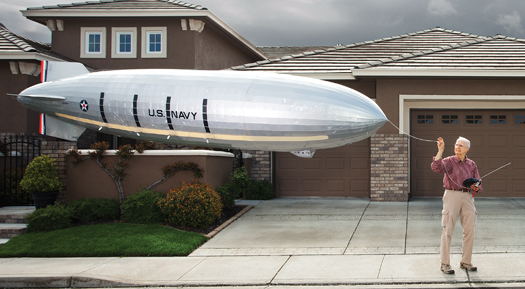

The first time retired computer engineer Jack Clemens tried to build a scale model of the USS Macon, a helium-filled naval airship lost in bad weather in 1935, his cat jumped on the prototype from a high shelf and ruined the hull. Clemens finished a second version in 2008 but totaled it during an unexpectedly windy test flight. Finally, in April, Clemens completed version number 3, a 20-foot-long radio-controlled replica accurate down to practically every detail, from the airbag to the propellers.
Click here to see how the giant model works.
Clemens frequently used to commute past the Macon’s enormous hangar in Moffett Field, California. He thought returning a model of the craft to its original home would be a fitting tribute, so he requested the plans from the Smithsonian National Air and Space Museum.
The Macon was an airship, not a blimp, meaning it had a rigid hull. A backbone made from 12 circular frames connected with strips of wood called longerons gave the 785-foot-long craft its form. Clemens wanted to mimic the structure in his model, so he built a jig to ensure that the frames–made from thousands of balsa-wood sticks–were precisely the right size. Although the Macon’s skin was a mix of cotton muslin and metal-colored sealant, Clemens’s model used Mylar because it was lightweight, tough and the right color.
Clemens calculated that to get his craft to fly, he would need a total of eight small model-airplane propellers anchored to the sides of the frame. “It takes very little propulsive force to move an airship,” he explains. The propellers are powered by a single 2.5-ounce lithium-polymer battery that sits in the nose of the craft and helps balance the weight of pulleys and servomotors in the tail.
Currently the 20-foot-long, 3.3-foot-diameter airship resides in Clemens’s garage (“It’s the bane of my wife’s existence,” he says), but he has offered to donate it to a new museum being built in Moffett Field. He’s hoping that one day he’ll even get the chance to fly it in the Macon’s original hangar, far away from strong winds and leaping cats.
Time: 2.5 years
Cost: $6,000




